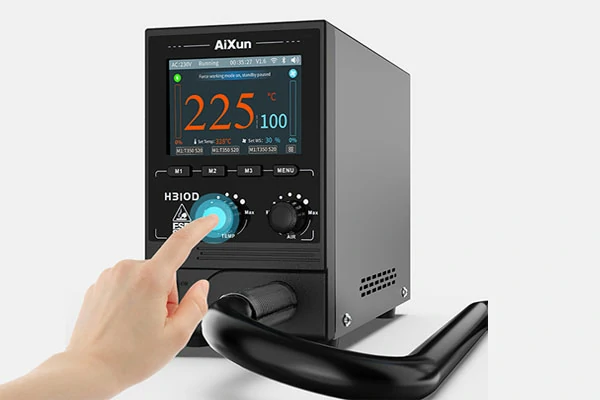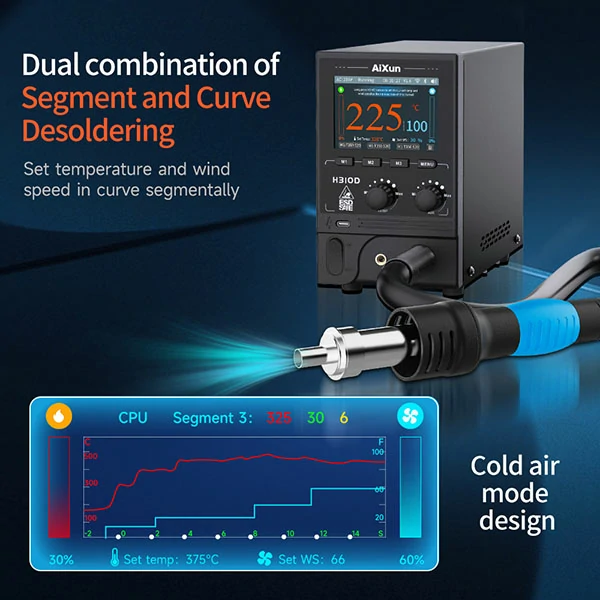
An SMD (Surface Mount Device) rework station is a specialized tool used in the electronics industry for repairing and reworking electronic components on printed circuit boards (PCBs) that employ surface mount technology. Unlike traditional through-hole components, SMDs are smaller, more compact, and soldered directly onto the surface of the PCB. This design offers several advantages, including space efficiency and better signal performance, but it also presents challenges when it comes to repairs and replacements.
SMD rework stations are designed to address these challenges by providing a controlled and precise way to remove, replace, and re-solder SMD components. These stations typically include features like temperature-controlled hot air rework tools, soldering irons, and preheating platforms, all of which are crucial for achieving reliable solder joints and preventing damage to delicate components.

The importance of SMD rework stations in the field of electronics repairs cannot be overstated. With the rapid advancement of technology, electronics are becoming increasingly compact and intricate, making it essential to have tools that allow for precise repairs. SMD components are commonly found in a wide range of devices, from smartphones and laptops to medical equipment and automotive electronics.
When these SMD components malfunction due to manufacturing defects, wear and tear, or even accidental damage, an SMD rework station becomes indispensable. It enables technicians to remove faulty components without damaging the surrounding circuitry, replace them with new components, and re-solder them to restore the device's functionality. This process helps extend the lifespan of electronic devices and reduces the need for complete replacements, which can be costly and environmentally wasteful.
Surface Mount Devices, commonly referred to as SMD components, are a type of electronic component that is designed to be soldered directly onto the surface of a printed circuit board (PCB). Unlike traditional through-hole components, which have leads that pass through holes in the PCB and are soldered on the opposite side, SMD components are mounted directly onto the board's surface using solder paste and reflow soldering techniques.
SMD components come in various shapes and sizes, including resistors, capacitors, diodes, transistors, integrated circuits (ICs), and more. These components are designed to be compact, lightweight, and suitable for high-density circuit designs, which has become a necessity as electronics continue to shrink in size while becoming more powerful.
The key distinction between SMD components and through-hole components lies in their mounting and soldering methods. Through-hole components are larger and require holes to be drilled through the PCB for their leads to pass through, making them suitable for manual soldering. On the other hand, SMD components are smaller and are directly soldered onto the PCB's surface, allowing for automated assembly and improved space utilization.
SMD components have a number of advantages, such as better thermal and electrical performance due to shorter connection paths, reduced manufacturing costs through automated assembly processes, and the ability to create more compact and lightweight devices.
SMD components are found in a wide range of electronic devices, from consumer electronics to industrial equipment. Their compact size and efficiency make them particularly well-suited for modern electronics. Some common applications of SMD components include:
Consumer Electronics: SMD components are prevalent in devices such as smartphones, tablets, laptops, televisions, and digital cameras. Their small size contributes to the sleek and lightweight designs of these devices.
Automotive Electronics: SMD components play a vital role in the automotive industry, powering everything from engine control units (ECUs) and infotainment systems to safety features and sensors.
Medical Devices: Medical equipment often utilizes SMD components for their reliability and precision. They can be found in devices like MRI machines, pacemakers, and blood glucose monitors.
Communication Systems: SMD components are essential in communication equipment like routers, modems, and wireless devices, enabling seamless connectivity.
Industrial Automation: SMD components are used in industrial automation systems for tasks like control, monitoring, and data processing.
Aerospace and Defense: SMD components are employed in aircraft avionics, satellites, and military equipment, where reliability and performance are critical.
1. Function and Operation
The hot air rework tool is one of the core components of an SMD rework station and is indispensable for removing and reworking SMD components. This tool uses a focused stream of heated air to soften solder joints, allowing for the careful removal or placement of components on the PCB. The hot air rework tool is particularly crucial for preventing damage to both the delicate components and the PCB itself.
Associated product: H310D 1000W Smart Hot Air Rework Station
During component removal, the hot air is directed at the solder joints, heating them to the point where the solder becomes molten. This allows the component to be gently lifted off the PCB. Similarly, during component placement, the tool helps melt the solder paste on the PCB pads, ensuring a secure connection when the new component is placed and the solder solidifies upon cooling.
2. Temperature and Airflow Control
Temperature and airflow control are vital features of the hot air rework tool. Different components and PCB materials require specific temperature profiles to avoid overheating or damaging the surrounding components. Many SMD rework stations offer adjustable temperature settings to accommodate various needs. Additionally, adjustable airflow helps control the rate at which the solder joints heat up and prevents overheating.
When using the hot air rework tool, it's important to follow manufacturer guidelines and recommendations for temperature and airflow settings. The ability to fine-tune these parameters ensures precise and controlled rework operations, reducing the risk of errors and ensuring successful repairs.
1. Role in SMD Rework
Apart from the hot air rework tool, an SMD rework station may also include a soldering iron or a preheater as additional components.
The soldering iron serves the purpose of localized soldering and desoldering. It's particularly useful for touch-up soldering, where minor repairs or adjustments need to be made to solder joints after the component has been placed. This iron allows for targeted heating and soldering on specific points of the PCB.
Alternatively, a preheater is employed to warm up the entire PCB evenly before using the hot air rework tool. Preheating helps in preventing thermal shock to the PCB and components during rework operations. It ensures that the PCB is at a consistent temperature, making the solder joints easier to work with and reducing the risk of damage due to sudden temperature changes.
2. Temperature Settings
For soldering irons and preheaters, precise temperature control is paramount. Different solder alloys and component types require specific temperatures to achieve reliable solder joints. Most soldering irons and preheaters allow you to adjust the temperature according to the needs of the particular component you're working with.
Using the appropriate temperature settings helps prevent overheating, which can lead to solder joint issues like cold solder joints or component damage.

Even if you're new to electronics and soldering, don't let that discourage you. With patience, attention to detail, and the right resources, you can gain confidence in working with SMD components and successfully repair various devices.
 WhatsApp
WhatsApp